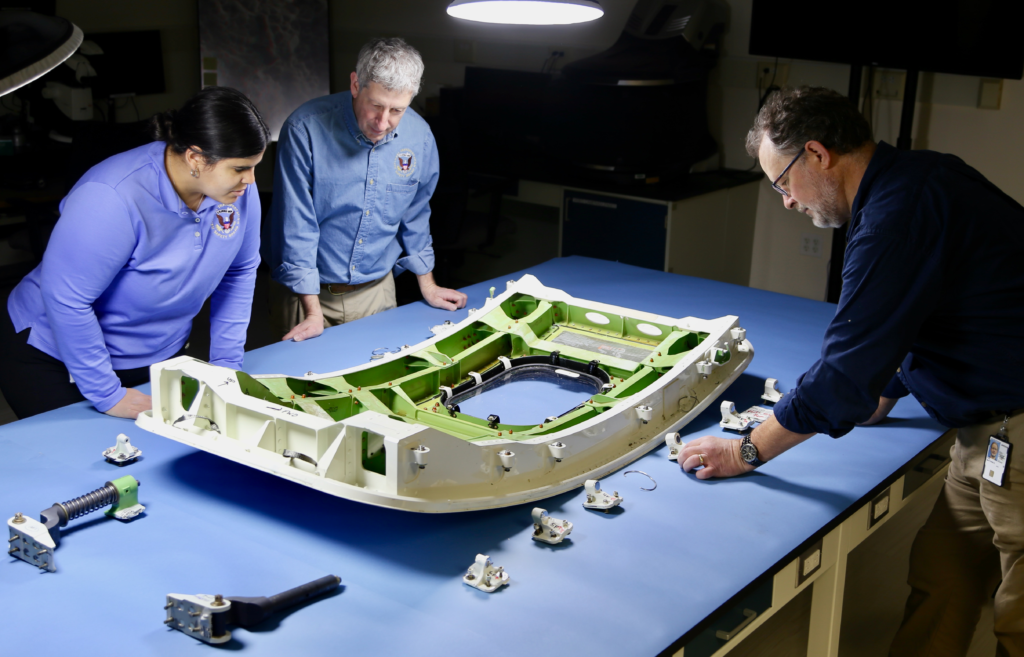ANCHORAGE- According to a recent report from the National Transportation Safety Board (NTSB), it appears that bolts were absent from a door plug that forcefully ejected midair on an Alaska Airlines (AS) Boeing 737 MAX 9 last month.
The incident occurred on January 5, causing a significant rupture in the fuselage while the fully occupied aircraft was ascending from Portland, Oregon, at an altitude of approximately 16,000 feet. The dislodged panel served as a plug for an unused emergency exit.

Alaska Airlines 737 MAX Missing Bolts
The NTSB’s preliminary report, released on Tuesday, stated, “Overall, the observed damage patterns and absence of contact damage or deformation around holes associated with the vertical movement arrestor bolts and upper guide track bolts in the upper guide fittings, hinge fittings, and recovered aft lower hinge guide fitting indicate that four bolts that prevent upward movement of the MED plug were missing before the MED plug moved upward off the stop pads.”
The initial investigation report on Flight 1282 offers detailed insights into the events leading up to the aircraft’s delivery to Alaska Airlines in late the previous year.
The fuselage, which included the door plug and was manufactured by Spirit AeroSystems, was delivered to Boeing’s Renton, Washington, facility on August 31. The following day, a repair entry was logged for five damaged rivets, necessitating the removal of bolts, as indicated by the National Transportation Safety Board (NTSB).
The ongoing investigation aims to ascertain which manufacturing documents were utilized to authorize the manipulation of the left door plug during the rivet rework, as stated by the NTSB.
Boeing acknowledged the efforts of the U.S. National Transportation Safety Board and expressed its commitment to promptly reviewing their findings. The company emphasized its full and transparent cooperation with both the NTSB and FAA investigations in a provided statement.


Increased Scrutiny on Boeing
The incident led to the Federal Aviation Administration (FAA) grounding the Max 9 for a significant part of the previous month. Although most of the Max 9 planes in the U.S. have since resumed operations.
Boeing’s CEO, Dave Calhoun, facing pressure to address manufacturing issues causing delays in aircraft deliveries, acknowledged the company’s responsibility for the mishap.
On a January 31 earnings call, Calhoun stated, “We caused the problem.” He further mentioned having challenging discussions with customers, regulators, congressional leaders, and others, expressing understanding of their concerns and pledging to regain their confidence.
In response to the manufacturing concerns, the FAA is conducting an audit of Boeing’s production lines and has announced a halt to the company’s plan to increase the production of the bestselling Max jet beyond the current rate of 38 per month until regulators are satisfied with the manufacturing processes.
Notably, the accident on January 5 occurred precisely as Boeing was working to accelerate its production output.
“In our examination of the NTSB’s preliminary report, our primary focus is on maintaining close collaboration with Boeing and regulatory authorities to continually enhance our processes and adhere to the highest standards of safety, quality, and reliability,” stated Spirit in a released statement.
Stay tuned with us. Further, follow us on social media for the latest updates.
Join us on Telegram Group for the Latest Aviation Updates. Subsequently, follow us on Google News.

